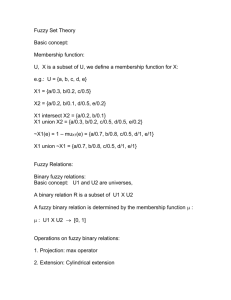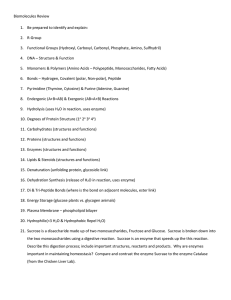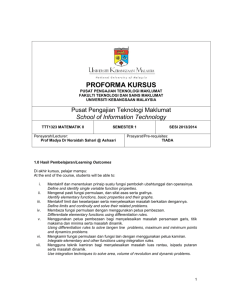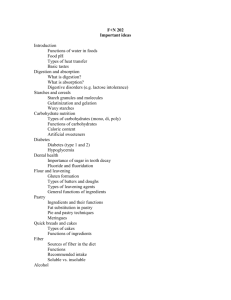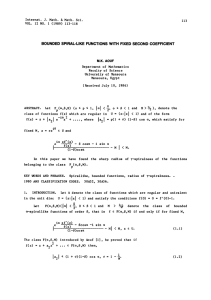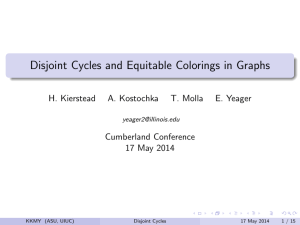Variations of non-additive measures Endre Pap
advertisement
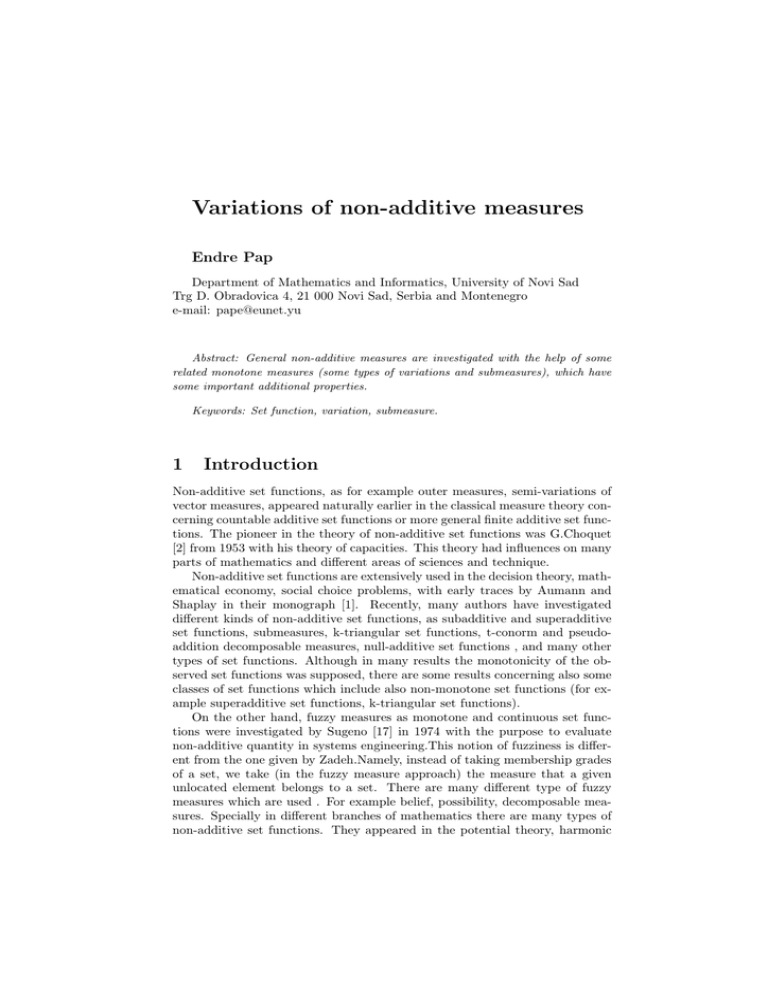
Variations of non-additive measures
Endre Pap
Department of Mathematics and Informatics, University of Novi Sad
Trg D. Obradovica 4, 21 000 Novi Sad, Serbia and Montenegro
e-mail: pape@eunet.yu
Abstract: General non-additive measures are investigated with the help of some
related monotone measures (some types of variations and submeasures), which have
some important additional properties.
Keywords: Set function, variation, submeasure.
1
Introduction
Non-additive set functions, as for example outer measures, semi-variations of
vector measures, appeared naturally earlier in the classical measure theory concerning countable additive set functions or more general finite additive set functions. The pioneer in the theory of non-additive set functions was G.Choquet
[2] from 1953 with his theory of capacities. This theory had influences on many
parts of mathematics and different areas of sciences and technique.
Non-additive set functions are extensively used in the decision theory, mathematical economy, social choice problems, with early traces by Aumann and
Shaplay in their monograph [1]. Recently, many authors have investigated
different kinds of non-additive set functions, as subadditive and superadditive
set functions, submeasures, k-triangular set functions, t-conorm and pseudoaddition decomposable measures, null-additive set functions , and many other
types of set functions. Although in many results the monotonicity of the observed set functions was supposed, there are some results concerning also some
classes of set functions which include also non-monotone set functions (for example superadditive set functions, k-triangular set functions).
On the other hand, fuzzy measures as monotone and continuous set functions were investigated by Sugeno [17] in 1974 with the purpose to evaluate
non-additive quantity in systems engineering.This notion of fuzziness is different from the one given by Zadeh.Namely, instead of taking membership grades
of a set, we take (in the fuzzy measure approach) the measure that a given
unlocated element belongs to a set. There are many different type of fuzzy
measures which are used . For example belief, possibility, decomposable measures. Specially in different branches of mathematics there are many types of
non-additive set functions. They appeared in the potential theory, harmonic
analysis, fractal geometry, functional analysis, theory of nonlinear differential
equations, theory of difference equations and optimizations. There are many
different fields in which the interest on non-additive set functions is growing up.
In the theory of the artificial intelligence, belief functions have been applied to
model uncertainty. Belief functions, corresponding plausibility measures and
other kinds of non-additive set functions are used in statistics. Non-additive
expected utility theory has been applied for example in multi-stage decision
and economics. Many aggregation operators are based on integrals related
to non-additive measures [9, 10, 12]. We can compare additive set functions
(which are base for the classical measure theory) and non-additive set functions in the following simple way. For a fixed set A ∈ Σ the classical measure
µ : Σ → [0, +∞] gives that for every set B from Σ such that A ∩ B = ∅ we have
that µ(A∪B)−µ(B) is always equal to a constant µ(A), i.e., it is independent of
B. In contrast, for non-additive set function m the difference m(A ∪ B) − m(B)
depends on B and can be interpreted as the effect of A joining B.
In this paper we will correspond to every set function ([1, 2, 13, 14, 15, 17,
18]) special positive set functions with some additional properties. Motivated
by the notion of the variation of the classical measure ([15, 16]) we introduce
axiomatically the notion of the variation of the general set function and prove
that it always exists, but in general case it is not unique. One of them so called
disjoint variation is based on the partition of the set and the other so called
chain variation is based on the chains of sets, see [1, 4, 14]. In this paper we
will prove that these variations have some additional properties with respect
to the starting non-additive set function. Among others that disjoint variation
is superadditive on any family of disjoint sets, see [14].
2
Variations
We start with some results from the classical measure theory. Let Σ be a σalgebra of subsets of the given set X. A set function µ : Σ → R is additive
(signed finitely additive measure) if we have
µ(A ∪ B) = µ(A) + µ(B)
for all A, B ∈ Σ with A ∩ B = ∅. A set function µ : Σ → R is σ−additive
(signed measure) if we have
̰ !
∞
[
X
µ
Ei =
µ(Ei )
i=1
i=1
for all pairwise disjoint sequences {Ei } from Σ, i.e., En ∩ Em = ∅ for n 6= m.
For an arbitrary but fixed subset A of X and an additive set function µ its
variation µ is defined by
X
µ(A) = sup
| µ(Di ) |,
I
i∈I
where the supremum is taken over all finite families {Di }i∈I of pairwise disjoint
sets of Σ such that ∪i∈I Di = A. It is well-known that if µ : Σ → R is finitely
(or countable) additive the µ is finitely (countable) additive. If µ is signed
additive set function then µ is countable additive if and only if µ is countable
additive.
We consider now general set functions m, m : D → [−∞, +∞], with
m(∅) = 0 (extended real-valued set function), see [14], where D denote a
family of subsets of a set X with ∅ ∈ D. m is (finite) real-valued set function
if −∞ < m(A) < +∞ for all A ∈ D, and m is monotone if A ⊂ B implies
m(A) ≤ m(B) for every A, B ∈ D. m is non-negative if it is finite and m(A) ≥ 0
for all A ∈ D, and m : D → [0, +∞] is positive.
We introduce for an arbitrary set function axiomatically a generalization of
the variation.
Definition 1 Let m be a set function defined on D with values in R (or
[0, +∞]), with m(∅) = 0. Then variation of m is a set function η : D → [0, +∞]
with the following properties:
(i) For every A ⊂ X we have
0 ≤ η(A) ≤ +∞;
(ii)
(iii)
(iv)
(v)
η(∅) = 0;
| m(A) |≤ η(A) (A ∈ D);
η is monotone, i.e., if B ⊂ A, then η(B) ≤ η(A);
η(A) = 0 if and only if m(B) = 0 for every subset B of A from D.
We easily obtain: For every A ⊂ X we have
η(A) ≥ sup{| m(B) |: B ⊂ A, B ∈ D}.
Namely, if B is a arbitrary subset of A which belongs to D we have by the
properties (iv) and (iii)
η(A) ≥ η(B) ≥| m(B) | .
3
The existence of variations
Theorem 1 For every set function m defined on D and with values in R (or
[0, +∞]), with m(∅) = 0, always exists its variation, which in general case is
not uniquely determined.
We introduce two special set functions related to a given set function m which
are base for the proof of the preceding theorem.
Definition 2 For an arbitrary but fixed subset A of X and a set function m
we define the disjoint variation m by
X
m(A) = sup
| m(Di ) |,
(1)
I
i∈I
where the supremum is taken over all finite families {Di }i∈I of pairwise disjoint
sets of D such that Di ⊂ A (i ∈ I).
Definition 3 For an arbitrary but fixed A ∈ D and a set function m we define
the chain variation | m | by
n
X
| m | (A) = sup{
| m(Ai ) − m(Ai−1 ) |:
i=1
∅ = A0 ⊂ A1 ⊂ · · · ⊂ An = A, Ai ∈ D, i = 1, . . . , n}.
(2)
We remark that the supremum in the previous definition is taken over all finite
chains between ∅ and A.
Proof of Theorem 1. Let m : D → R. We prove that m and | m | are
variations.
First we consider m:
(i) Follows by the definition of m.
(ii) Only family is I = {∅}, and so we have
m(∅) = sup Σ | m(∅) |= 0.
(iii) Since one of the families I of disjoint sets of D contained in A is the
family I = {A} we obtain by the definition of m the desired inequality.
(iv) Since for any family {Di }i∈I of disjoint sets of D with property Di ⊂
B (i ∈ I), by B ⊂ A, we have Di ⊂ A, too, we obtain
X
| m(Di ) |≤ m(A),
i∈I
and so m(B) ≤ m(A).
(v) Let us suppose that m(A) = 0 for an arbitrary set A ⊂ X. Then by (v)
we obtain
m(B) = 0 for each B ⊂ A, B ∈ D.
Suppose now that m(B) = 0 for each B ⊂ A, B ∈ D. Then for each finite
family {Di }i∈I of disjoint sets such that Di ⊂ A (i ∈ I) we obtain
X
| m(Di ) |= 0.
i∈I
This implies m(A) = 0.
We consider now | m |:
(i) Follows by (2).
(ii) Every chain connecting ∅ with ∅ consists only of empty set, therefore
X
| m | (∅) = sup{
| m(Ai ) − m(Ai−1 ) |:
∅ = A0 ⊂ An = ∅} = 0.
(iii) One of the chain which connects ∅ and the set A consists only of ∅
and A, i.e., ∅ = A0 ⊂ An = A, therefore
| m(A) | = sup{| m(A) − m(∅) |:
∅ = A0 ⊂ An = A} ≤ | m | (A).
(iv) Some of chains from ∅ to A contain chains from ∅ to B, (exhaust all
of them), therefore
| m | (B) = sup{
n
X
| m(Ai ) − m(Ai−1 ) |:
i=1
∅ = A0 ⊂ A1 ⊂ · · · ⊂ An = B, Ai ∈ D, i = 1, ..., n}
s
X
≤ sup{
| m(Ai ) − m(Ai−1 ) |:
i=1
∅ ⊂ A0 ⊂ A1 ⊂ · · · ⊂ As = A, Ai ∈ D, i = 1, ..., s}
=| m | (A).
(v) Suppose | m | (A) = 0. Then for every set B ⊂ A, B ∈ D, we have by
(v) m(B) = 0.
Conversely, if m(B) = 0 for every set B ⊂ A, B ∈ D, then for any chain
∅ = A0 ⊂ A1 ⊂ ... ⊂ An = A we have m(Ai ) = 0, i = 1, 2, ..., n, and so
n
X
| m(Ai ) − m(Ai−1 ) |= 0.
i=1
Hence | m | (A) = 0.
Finally we shall show that generally m 6=| m | . Let X = {a, b}. Define
m : P(X) → R by m({a}) = 2, m({b}) = 3, m({a, b}) = 4. Then m({a, b}) =
5 6= 4 =| m | ({a, b}).
¤
Remark 1 (i) If D is an algebra, then we can take for A ∈ DSin (1) the
Di = A.
supremum for all finite families {Di }i∈I of disjoint sets such that
i∈I
(ii) We note that the variation m given by (1) is defined on P(X).
Let D be a ring. A set function m : D → R is superadditive if for every
A, B ∈ D with A ∩ B = ∅ we have m(A ∪ B) ≥ m(A) + m(B), and it is
subadditive if for every A, B ∈ D with A ∩ B = ∅ we have m(A ∪ B) ≤
m(A) + m(B).
Theorem 2 Let m be a set function defined on Σ with values in R (or [0, +∞]),
with m(∅) = 0. Then the set function m given by (1) is superadditive, i.e.,
Ã
!
X
[
m(Ei ) ≤ m
Ei
i∈I
i∈I
for each family {Ei }i∈I of disjoint sets of X.
Proof. Suppose that m 6= 0. We take two arbitrary but fixed disjoint subset
E1 and E2 of X such that m is different from zero on at least one of them. We
take an arbitrary but fixed real number r such that
m(E1 ) + m(E2 ) > r.
(3)
Therefore there exist two real numbers r1 and r2 such that r = r1 + r2 and
m(E1 ) > r1
Then there exists a finite family
E1 (i = 1, 2, . . . , n) such that
n
X
and
m(E2 ) > r2 .
{Di1 }1≤i≤n
of disjoint sets from Σ with Di1 ⊂
| m(Di1 ) | > r1 ,
(4)
i=1
and a finite family {Di2 }1≤j≤k of disjoint sets from Σ, with Dj2 ⊂ E2 (j =
1, 2, . . . , k), such that
k
X
| m(Dj2 ) | > r2 .
(5)
j=1
The family of sets
{D11 , D21 , . . . , Dn1 , D12 , D22 , . . . , Dk2 }
consists of disjoint sets from Σ which are contained in E1 ∪ E2 and by (1) we
obtain
k
n
X
X
| m(Dj2 ) | .
m(E1 ∪ E2 ) ≥
| m(Di1 ) | +
j=1
i=1
Therefore by the inequalities (4) and (5)
m(E1 ∪ E2 ) > r1 + r2 = r.
(6)
Since the number r was arbitrary such that the inequality (3) is satisfied, we
conclude that
m(E1 ) + m(E2 ) ≤ m(E1 ∪ E2 )
since the opposite inequality is impossible by (6).
The preceding inequality holds by induction for every finite family {Ei }i∈J
of disjoint subsets of X, i.e.,
Ã
!
X
[
m(Ei ) ≤ m
Ei .
i∈J
i∈J
For an arbitrary family {Ei }i∈I of disjoint subset of X we obtain by the preceding step that for each finite subset J of I
Ã
Ã
!
!
[
[
X
m
m(Ei ).
Ei ≥ m
Ei ≥
i∈I
i∈J
i∈J
Therefore
Ã
m
[
!
Ei
≥
i∈I
X
m(Ei ).
i∈I
¤
Open problem: Find all variations of a given arbitrary set function m.
We shall give a partial answer on this problem, when we require some
additional properties of the variation.
Theorem 3 Let m be a set function defined on Σ with values in R (or [0, +∞]),
with m(∅) = 0. Then m given by (1) is the smallest variation of m (defined on
P(X)) which is superadditive.
Proof. By Theorem 2 variation m is superadditive. Then theorem follows by
the properties of any superadditive variation η of m taking an arbitrary finite
family {Di }i∈I of disjoint sets from Σ contained in A, i.e.,
Ã
!
[
X
X
η(A) ≥ η
Di ≥
η(Di ) ≥
| m(Di ) | .
i∈I
i∈I
i∈I
Hence η(A) ≥ m(A).
¤
Open problem: Find all variations of a given arbitrary set function m.
We shall give a partial answer on this problem, when we require some
additional properties of the variation.
Theorem 4 Let m be a set function defined on Σ with values in R (or [0, +∞]),
with m(∅) = 0. Then m given by (1) is the smallest variation of m (defined on
P(X)) which is superadditive.
4
Submeasures
For non-negative monotone set function m with an additional topological property we can correspond a submeasure ξ (monotone and subadditive set function) which is closely topologically connected with m, see for more details
[6, 7, 13, 14].
Theorem 5 Let D be a ring and m : D → [0, ∞) be monotone. Then there
exists a submeasure ξ on D such that
m(En ) → 0 ⇔ ξ(En ) → 0,
if and only if m satisfies the following condition:
(ac) m(An ) + m(Bn ) → 0,
then m(An ∪ Bn ) → 0.
The work was supported by the grant MNTRS-1866 and the Vojvodina
Academy of Sciences and Arts..
References
[1] R. J. Aumann, L. S. Shapley, Values of Non-Atomic Games, Princ. Univ.
Press, 1974.
[2] G. Choquet, Theory of capacities, Ann. Inst. Fourier (Grenoble) 5 (195354), 131-292.
[3] D. Denneberg, Non-Additive Measure and Integral, Kluwer Academic Publishers, Dordrecht, 1994.
[4] N. Dinculeanu, Vector Measures. Pergamon Press, New York, 1967.
[5] I. Dobrakov, On submeasures-I, Dissertationes Math. 112, Warszawa,
1974.
[6] L. Drewnowski, Topological rings of sets, continuous set functions, integration, I, II, III, Bull. Acad. Polon. Sci. Ser. Math. Astronom. Phys. 20
(1972), 269-276, 277-286, 439-445.
[7] L. Drewnowski, On the continuity of certain non-additive set functions,
Colloquium Math. 38 (1978), 243-253.
[8] M. Grabish, T. Murofushi, M. Sugeno, Fuzzy measure of fuzzy events
defined by fuzzy integrals, Fuzzy Sets and Systems 50 (1992) , 293-313.
[9] M. Grabisch, H.T. Nguyen and E.A. Walker, Fundamentals of Uncertainty
Calculi with Applications to Fuzzy Inference. Kluwer Academic Publishers,
Dordercht, 1995.
[10] M. Grabisch, T. Murofushi, M. Sugeno, eds.: Fuzzy Measures and Integrals. Theory and Applications. Physica-Verlag, Heidelberg, 2000.
[11] E. P. Klement, R. Mesiar, E. Pap, Integration with respect to decomposable measures, based on a conditionally distributive semiring on the
unit interval, Internat. J. Uncertain. Fuzziness Knowledge-Based Systems
8 (2000), 701-717.
[12] E. P. Klement, R. Mesiar, E. Pap, Measure-based aggregation operators,
Fuzzy Sets and Systems 142 (2004), 3-14.
[13] E. Pap, On non-additive set functions. Atti. Sem. Mat. Fis. Univ. Modena
39 (1991), 345-360.
[14] E. Pap, Null-Additive Set Functions. Kluwer Academic Publishers, Dordrecht, Ister Science, Bratislava, 1995.
[15] E. Pap (Ed.), Handbook of Measure Theory. Elsevier, North-Holland, 2002.
[16] W. Rudin, Real and Complex Analysis. Mc Graw-Hill, 1966.
[17] M. Sugeno, Theory of fuzzy integrals and its applications. Ph.D.Thesis,
Tokyo Institute of Technology, 1974.
[18] Z. Wang, G. Klir, Fuzzy measures. Plenum Press, New York, 1992.
